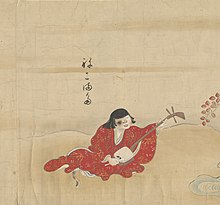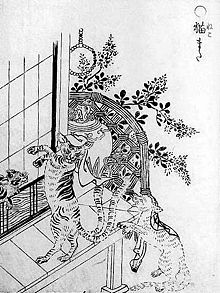This is the current revision of this page, as edited by AHI-3000 (talk | contribs) at 21:06, 10 January 2025 (→External links). The present address (URL) is a permanent link to this version.
Revision as of 21:06, 10 January 2025 by AHI-3000 (talk | contribs) (→External links)(diff) ← Previous revision | Latest revision (diff) | Newer revision → (diff) Kind of cat monster in Japanese folklore

Nekomata (original form: 猫また, later forms: 猫又, 猫股, 猫胯) are a kind of cat yōkai described in Japanese folklore, classical kaidan, essays, etc. There are two very different types: those that live in the mountains and domestic cats that have grown old and transformed into yōkai.
Nekomata are often confused with bakeneko. The Nekomata has multiple tails, while the Bakeneko has one. Additionally while the Bakeneko is often mischievous and playful, the Nekomata is considered far more malicious in its behaviour.
Mountain Nekomata

Nekomata appear in stories even earlier than in Japan. In the Sui dynasty, the words 猫鬼 and 金花猫 described mysterious cats. In Japanese literature, the nekomata first appeared in the Meigetsuki by Fujiwara no Teika in the early Kamakura period: in the beginning of Tenpuku (1233), August 2, in Nanto (now Nara Prefecture), a nekomata (猫胯) was said to have killed and eaten several people in one night. The nekomata was described as a mountain beast: according to the Meigetsuki, "They have eyes like a cat, and have a large body like a dog." An essay in Yoshida Kenkō 's 1331 Tsurezuregusa asserts, "In the mountain recesses, there are those called nekomata, and people say that they eat humans... (奥山に、猫またといふものありて、人を食ふなると人の言ひけるに……)."
Many people question whether the nekomata is a cat monster. Since people are said to suffer an illness called "nekomata disease (猫跨病)", some interpret the nekomata to be a beast that has caught rabies.
Even in the kaidan collections, the "Tonoigusa (宿直草)" and the "Sorori Monogatari (曾呂利物語)," nekomata conceal themselves in mountain recesses. There are stories that deep in the mountains they shapeshift into humans. In folk religion there are many stories of mountainous nekomata. In later literature, the mountain nekomata tend to be larger. In the "Shin Chomonjū (新著聞集)" nekomata captured in the mountains of Kii Province are as large as a wild boar; in the "Wakun no Shiori (倭訓栞)" of 1775 (Anei 4), their roaring echos throughout the mountain, and they can be seen as big as a lion or leopard. In the "Gūisō (寓意草)" of 1809 (Bunka 6), a nekomata that held a dog in its mouth was described as having a span of 9 shaku and 5 sun (about 2.8 meters).
In Etchū Province (now Toyama Prefecture), in Aizu, at Nekomatayama said to be where nekomata would devour humans (now Fukushima Prefecture), nekomata that shapeshift into humans and deceive people, like Mount Nekomadake, the legends sometimes are named after the name of the associated mountain. Regarding Nekomatayama and altogether disregarding folklore, there are large cats that attack humans.
Domestic Cat Nekomata
At the same time, in the setsuwa collection Kokon Chomonjū, in the story "Kankyō Hōin (観教法印)", an old cat raised in a villa on a mountain precipice held a secret treasure, a protective sword, in its mouth and ran away. People chased the cat, but it disguised itself. In the aforementioned Tsurezuregusa, aside from nekomata that conceal themselves in the mountains, there are descriptions of pet cats that grow old, transform, and eat and abduct people.
Since the Edo period, it has become generally believed that domestic cats turn into nekomata as they grow old, and mountainous nekomata have come to be interpreted as cats that have run away to live in the mountains. As a result, throughout Japan, a folk belief developed that cats should not be kept for long periods.
In the "Ansai Zuihitsu (安斎随筆)" the courtier Sadatake Ise stated, "A cat that is several years of age will come to have two tails, and become the yōkai called nekomata." The mid-Edo period scholar Arai Hakuseki stated, "Old cats become 'nekomata' and bewilder people." and indicated that at that time it was common to believe that cats become nekomata. Even the Edo-period Kawaraban reported this strange phenomenon.
In the book Yamato Kaiiki (大和怪異記 "Mysterious stories from Japan"), written by an unknown author in 1708, one story speaks of a rich samurai's haunted house where the inhabitants witnessed several poltergeist activities. Attempting to end those events, the samurai called upon countless shamans, priests and evokers; but none of them could locate the source of the terror. One day, one of the most loyal servants saw his master's aged cat carrying in its mouth a shikigami with the samurai's name imprinted on it. Immediately shooting a sacred arrow, the servant hit the cat in its head; and as it lay dead on the floor, everyone could see that the cat had two tails and therefore had become a nekomata. With its death, the poltergeist activities ended. Similar eerie stories about encounters with nekomata appear in books such as Taihei Hyakumonogatari (太平百物語, engl. Collection of 100 fairy tales), written by Yusuke (祐佐, or Yūsa) in 1723 and in Rōō Chabanashi (老媼茶話, Tea-time gossip of old ladies), by Misaka Daiyata (三坂大彌), 1742.
It is generally said that the "mata" (又) of "nekomata" refers to their having two tails, but from the perspective of folkloristics, this appears questionable. Since nekomata transform as they age, mata "repetition" is postulated. Alternatively, since they were once thought to be mountain beasts, there is a theory that "mata" (爰) refers to monkeys since nekomata can come and go freely among the mountain trees. There is also a theory that the term derives from how cats that grow old shed the skin off their backs and hang downwards, making it appear that they have two tails.
In Japan, cats are often associated with death, and this particular spirit is usually blamed. Far darker and more malevolent than most bakeneko, the nekomata is said to have powers of necromancy and, upon raising the dead, will control them with ritualistic dances, gesturing with paw and tail. These yōkai are associated with strange fires and other inexplicable occurrences. The older and more abused a cat is before its transformation, the more power the nekomata is said to have. To gain revenge against those who wronged it, the spirit may haunt humans with visitations from their deceased relatives. Some tales state that these demons, like bakeneko, assume human appearances, usually appearing as older women, misbehaving in public, and bringing gloom and malevolence wherever they travel. Due to these beliefs, sometimes kittens' tails were cut off based on the assumption that if the tails could not fork, the cats could not become nekomata.
From this discernment and strange characteristics, nekomata have been considered devilish from time immemorial. Due to fears and folk beliefs such as the dead resurrecting at a funeral or that seven generations would be cursed due to killing a cat, it is thought that the legend of the nekomata was born. Also, in folk beliefs cats and the dead are related. As carnivores, cats have a keen sense of detecting the smell of rot, so it was believed that they had a habit of approaching corpses; with this folk belief sometimes the kasha, a yōkai that steals corpses are seen to be the same as the nekomata.
Also in Japan there are cat yōkai called bakeneko; and since nekomata are the yōkai of transformed cats, sometimes nekomata are confused with bakeneko.
Yōkai Depictions


In the Edo period many books illustrating and describing yōkai were published (yōkai emaki), with nekomata frequently depicted. The Hyakkai Zukan published in 1737 (Gembun 2) includes an illustration of a nekomata assuming the appearance of a woman playing a shamisen. (See the first image on this page.) Since Edo-period shamisen frequently used cat skins, that particular nekomata sang a sad song about its species as it plucked the strings. Understandably, the image has been interpreted as ironic. As for the nekomata's wearing geisha clothing, sometimes nekomata and geisha are considered related since geisha were once called "cats (neko)"
Also shown at the right, the Gazu Hyakki Yagyō of 1776 (An'ei 5) depicts a cat with its head protruding from a shōji screen, a cat with a handkerchief on its head and its forepaw on the veranda, and a cat wearing a handkerchief and standing upright. The less experienced cat has difficulty standing on its hind legs. The older cat can do so: this is showing the process by which a normal cat ages and transforms into a nekomata. In the Bigelow ukiyo-e collection at the Museum of Fine Arts, Boston, the Hyakki Yagyō Emaki includes a similar composition, leading some scholars to see a relationship between the books.
Senri
In Chinese lore there is a cat monster called the xiānlí (仙狸)" (Japanese pronunciation senri, where "Chinese: 狸" means "leopard cat"). In this telling, leopard cats that grow old gain a divine spiritual power (xian arts), shapeshift into a beautiful man or woman, and suck the spirit out of humans. Some theorize that the Japanese nekomata legends derive from Chinese xiānlí tales.
See also
- Kasha
- Kaibyō
- Kuroneko — a 1968 horror film featuring vengeful cat spirits
- Maneki-neko
Notes
- ^ 多田 (2000)、170–171頁。
- ^ 笹間 (1994)、127–128頁。
- ^ 平岩 (1992)、36–66頁。
- ^ 石川 (1986)、696頁。
- 荻田安静編著 (1989). "宿直草". In 高田衛編・校中 (ed.). 江戸怪談集. 岩波文庫. Vol. 上. 岩波書店. pp. 121–124. ISBN 978-4-00-302571-0.
- 編著者不詳 (1989). "曾呂利物語". In 高田衛編・校中 (ed.). 江戸怪談集. 岩波文庫. Vol. 中. 岩波書店. pp. 57–58. ISBN 978-4-00-302572-7.
- 谷川健一 (1998). 続 日本の地名. 岩波新書. 岩波書店. p. 146. ISBN 978-4-00-430559-0.
- 日野巌 (2006). 動物妖怪譚. 中公文庫. Vol. 下. 中央公論新社. pp. 158–159. ISBN 978-4-12-204792-1.
- "ネコのうんちく". Nyanmaru.com. Archived from the original on 2012-11-14. Retrieved 2012-11-03.
- 佐野賢治他 (1980). 桜井徳太郎編 (ed.). 民間信仰辞典. 東京堂出版. p. 223. ISBN 978-4-490-10137-9.
- 京極夏彦 (2010). "妖怪の宴 妖怪の匣 第6回". In 郡司聡他編 (ed.). 怪. カドカワムック. Vol. 0029. 角川書店. p. 122. ISBN 978-4-04-885055-1.
- ^ 古山他 (2005)、155頁。
- 湯本豪一編著 (2006). 続・妖怪図巻. 国書刊行会. pp. 161–165. ISBN 978-4-336-04778-6.
- 新紀元社編集部 (2003). 健部伸明監修 (ed.). 真・女神転生悪魔事典. Truth In Fantasy. 新紀元社. p. 94. ISBN 978-4-7753-0149-4.
- 一条真也監修 (2010). 世界の幻獣エンサイクロペディア. 講談社. p. 194. ISBN 978-4-06-215952-4.
References
- 石川純一郎他 (1986). 乾克己他編 (ed.). 日本伝奇伝説大事典. 角川書店. ISBN 978-4-04-031300-9.
- 笹間良彦 (1994). 図説・日本未確認生物事典. 柏書房. ISBN 978-4-7601-1299-9.
- 多田克己 (2000). 京極夏彦・多田克己編 (ed.). 妖怪図巻. 国書刊行会. ISBN 978-4-336-04187-6.
- 平岩米吉 (1992). "猫股伝説の変遷". 猫の歴史と奇話. 築地書館. ISBN 978-4-806-72339-4.
- 古山桂子他 (2005). 播磨学研究所編 (ed.). 播磨の民俗探訪. 神戸新聞総合出版センター. ISBN 978-4-343-00341-6.
- Patrick Drazen: A Gathering of Spirits: Japan's Ghost Story Tradition: from Folklore and Kabuki to Anime and Manga. iUniverse, New York 2011, ISBN 1-4620-2942-6, page 114.
- Elli Kohen: World history and myths of cats. Lewiston, New York: Edwin Mellen Press 2003, ISBN 0-7734-6778-5, page 48–51.
- Carl Van Vechten: The Tiger In The House. Kessinger Publishing, Whitefish 2004 (Reprint), ISBN 1-4179-6744-7, page 96.
External links
- Nekomata – The Split-Tailed Cat at hyakumonogatari.com (English)